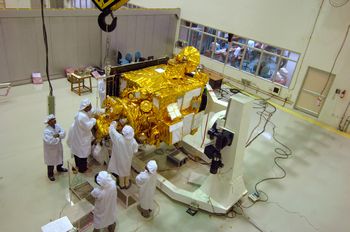India makes history with Chandrayaan 1
22 Oct 08, 10:25am

22 Oct 08, 10:25am

Indian Space Research Organization's first first unmanned lunar exploration mission, Chandrayaan 1 launched successfully from Satish Dhawan Space Centre in Sriharikotta, Andra Pradesh on Wednesday morning.
India makes history by entering a lunar club after USA, former Soviet Union, European Space Agency, China and Japan.
As planned at 6:22am Polar Satellite Launch Vehicle (PSLV C11) carrying the 650kg Chandrayaan 1 spacecraft blasted off from Sriharikotta. After 18.2 anxious minutes PSLV put spacecraft into a Tansfer Orbit at a perigee of about 250 km and apogee of about 23,000 km.
ISRO Chairman G Madhavan Nair described the launch as "perfect" and the moment as "historic".
Chandrayaan 1 spacecraft would take another 14 days to reach the moon travelling 4 lakh kilometers. It would be placed in a lunar orbit just 100km above moon's surface.
The Chandrayaan spacecraft to be controlled from ISRO Telemetry, Tracking and Command Network (Istrac) at Peenya in Bangalore.
Now the Liquid Apogee Motor (LAM) will be fired and Chandrayaan will move towards Moon. When it nears moon LAM will be fired in the opposite direction to reduce the gravitational force.
When it reaches the lunar orbit it would eject a Moon Impact Probe (MIP) which would crash-land on lunar surface to study about dropping an object to moon's surface which would help ISRO in it's future Chandrayaan projects.
Life period of the spacecraft is two years and during the time it would send data to earth from it's 5 Indian and 6 foreign payloads.
India makes history by entering a lunar club after USA, former Soviet Union, European Space Agency, China and Japan.
As planned at 6:22am Polar Satellite Launch Vehicle (PSLV C11) carrying the 650kg Chandrayaan 1 spacecraft blasted off from Sriharikotta. After 18.2 anxious minutes PSLV put spacecraft into a Tansfer Orbit at a perigee of about 250 km and apogee of about 23,000 km.
ISRO Chairman G Madhavan Nair described the launch as "perfect" and the moment as "historic".
Chandrayaan 1 spacecraft would take another 14 days to reach the moon travelling 4 lakh kilometers. It would be placed in a lunar orbit just 100km above moon's surface.
The Chandrayaan spacecraft to be controlled from ISRO Telemetry, Tracking and Command Network (Istrac) at Peenya in Bangalore.
Now the Liquid Apogee Motor (LAM) will be fired and Chandrayaan will move towards Moon. When it nears moon LAM will be fired in the opposite direction to reduce the gravitational force.
When it reaches the lunar orbit it would eject a Moon Impact Probe (MIP) which would crash-land on lunar surface to study about dropping an object to moon's surface which would help ISRO in it's future Chandrayaan projects.
Life period of the spacecraft is two years and during the time it would send data to earth from it's 5 Indian and 6 foreign payloads.
 Amaran
Amaran Brother
Brother Lucky Baskhar
Lucky Baskhar Vettaiyan
Vettaiyan Meiyazhagan
Meiyazhagan Thangalaan
Thangalaan The Greatest Of All Time
The Greatest Of All Time Mazhai Pidikkatha Manithan
Mazhai Pidikkatha Manithan